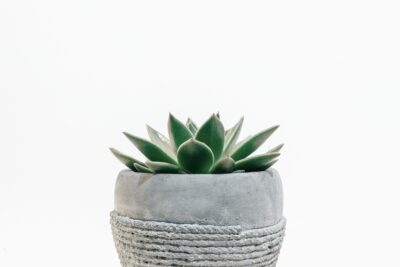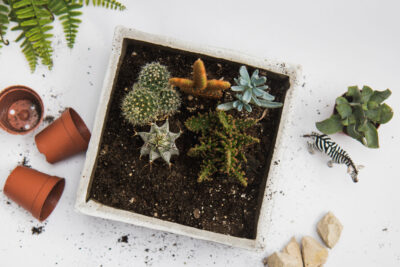
Encouraging Long Stems and Flowers in Succulents

Succulents are a type of plant that have adapted to survive in arid climates by storing water in their leaves, stems, and roots. They are known for their thick, fleshy leaves and their ability to thrive in dry conditions. While succulents are generally low-maintenance plants, one common issue that many succulent owners face is the development of long stems and sparse flowers. We will explore why succulents sometimes grow long stems and discuss how to encourage the growth of more compact plants with abundant flowers.
In the first section of the article, we will delve into the reasons why succulents develop long stems. This may be due to factors such as insufficient light, incorrect watering, or improper pruning techniques. We will provide tips and techniques to prevent elongation and promote more compact growth in succulents. Additionally, we will discuss the importance of proper watering and lighting conditions for succulents, as these factors play a crucial role in their overall health and development.
- Provide adequate sunlight for your succulents to encourage long stems and flowers
- Use a well-draining soil mix to prevent root rot and promote healthy growth
- Provide ample sunlight for optimal growth and blooming
- Water sparingly and avoid overwatering
- Fertilize occasionally for extra nutrients
- Water your succulents sparingly, allowing the soil to dry out between waterings
- Fertilize your succulents with a balanced fertilizer during their active growing season
- Prune your succulents regularly to remove dead or leggy growth and promote bushier growth
- Consider using grow lights to supplement natural sunlight for indoor succulents
- Avoid overpotting your succulents, as this can lead to overcrowded roots and hinder growth
- Monitor the temperature and humidity levels to ensure your succulents are in their optimal conditions
- Provide proper airflow around your succulents to prevent mold and encourage healthy growth
- Protect your succulents from extreme weather conditions, such as frost or excessive heat
- Frequently Asked Questions
Provide adequate sunlight for your succulents to encourage long stems and flowers
One of the key factors in encouraging long stems and flowers in succulents is providing them with adequate sunlight. Succulents are naturally adapted to thrive in bright and sunny conditions, so it's important to ensure they receive enough light to support their growth and blooming potential.
When positioning your succulents, it's best to place them in an area that receives at least six hours of direct sunlight per day. This can be achieved by placing them near a south-facing window or outdoors in a spot that receives ample sunlight. If you are growing succulents indoors, you may need to supplement their light exposure with artificial grow lights to ensure they receive enough light.
Remember, while succulents love sunlight, it's crucial to strike a balance and avoid exposing them to intense, scorching sunlight for prolonged periods. This can lead to sunburn and damage the plants. If you notice signs of sunburn, such as brown or discolored patches on the leaves, consider moving the succulents to a slightly shadier spot or providing some form of shade during the hottest parts of the day.
Rotate your succulents regularly to promote even growth
Another way to encourage long stems and flowers in succulents is by regularly rotating them. Succulents tend to grow towards the direction of the light source, resulting in uneven growth and potentially leggy stems. By rotating your succulents every few weeks, you can promote even growth and prevent them from leaning towards one direction.
To rotate your succulents, simply turn the pots or containers a quarter or half turn in either direction. This allows all sides of the plant to receive equal sunlight, encouraging symmetrical growth. Additionally, rotating the succulents can also help prevent them from becoming top-heavy and toppling over due to uneven growth.
 Can Succulents Thrive in Full Sunlight Without Suffering Damage?
Can Succulents Thrive in Full Sunlight Without Suffering Damage?Use well-draining soil and water sparingly
Succulents thrive in well-draining soil that allows excess water to flow out easily. When planting or repotting your succulents, choose a specialized succulent or cactus potting mix that is formulated to provide excellent drainage. This helps prevent waterlogged soil, which can lead to root rot and hinder the growth of long stems and flowers.
When it comes to watering succulents, it's important to remember that they are adapted to survive in arid conditions. Overwatering can be more detrimental to succulents than underwatering. Allow the soil to dry out between waterings, and when watering, do so thoroughly but sparingly. Ensure that excess water drains out of the pot completely, and avoid letting the succulents sit in standing water.
By providing adequate sunlight, regular rotation, and using well-draining soil, you can encourage the growth of long stems and beautiful flowers in your succulents. Remember to observe your succulents closely and adjust their care accordingly based on their specific needs. With proper care, your succulents will thrive and bring you joy with their stunning blooms.
Use a well-draining soil mix to prevent root rot and promote healthy growth
When it comes to succulents, one of the key factors in encouraging long stems and flowers is the type of soil mix you use. Succulents are native to arid regions and have adapted to survive in sandy, well-draining soils. Therefore, it's important to replicate these conditions when growing them.
Avoid using regular potting soil, as it tends to retain too much moisture and can lead to root rot. Instead, opt for a well-draining soil mix specifically formulated for succulents and cacti. These mixes usually consist of a combination of sand, perlite, and coarse gravel, which allows excess water to flow out quickly, preventing the roots from sitting in stagnant water.
When repotting your succulents, make sure to choose a pot with drainage holes at the bottom. This will further aid in preventing waterlogged soil and promote healthy root growth. Additionally, consider adding a layer of small rocks or broken pottery shards at the bottom of the pot to enhance drainage.
Provide ample sunlight for optimal growth and blooming
Succulents thrive in bright, indirect sunlight. To encourage long stems and flowers, it's crucial to provide them with ample light. Place your succulents near a south-facing window or in a spot where they can receive at least six hours of indirect sunlight per day.
 Cold Hardy Succulents: Flourishing in Chilly Climates
Cold Hardy Succulents: Flourishing in Chilly ClimatesIf you notice your succulents stretching or leaning towards the light source, it's an indication that they are not receiving enough light. In this case, consider using grow lights to supplement their sunlight requirements. Position the lights about 6-12 inches above the plants and provide them with 10-12 hours of artificial light per day.
Water sparingly and avoid overwatering
One of the most common mistakes in succulent care is overwatering. Succulents have adapted to survive in dry conditions and are capable of storing water in their leaves and stems. Therefore, they have low water requirements compared to other plants.
Water your succulents sparingly, allowing the soil to dry out completely between waterings. Stick your finger about an inch into the soil, and if it feels dry, it's time to water. Always remember that it's better to underwater than overwater your succulents.
When watering, make sure to drench the soil thoroughly and let any excess water drain out of the pot. Avoid leaving your succulents sitting in standing water, as this can lead to root rot. Additionally, reduce watering during the winter months when succulents enter a period of dormancy.
Fertilize occasionally for extra nutrients
Succulents are relatively low-maintenance plants and don't require frequent fertilization. However, providing them with occasional nutrients can help promote long stems and vibrant flowers.
During the active growing season, which is typically spring and summer, you can fertilize your succulents once a month with a balanced, water-soluble fertilizer diluted to half the recommended strength. Avoid overfertilizing, as this can lead to excessive growth and weak stems.
Remember to always follow the instructions on the fertilizer packaging and adjust the frequency and strength of application based on the specific needs of your succulents.
 What Temperature is Too Hot for Succulents?
What Temperature is Too Hot for Succulents?Water your succulents sparingly, allowing the soil to dry out between waterings
Succulents are known for their ability to store water in their leaves, stems, and roots, making them highly adapted to survive in arid conditions. Therefore, it is crucial to water them sparingly to prevent overhydration, which can lead to root rot and other issues.
To encourage long stems and flowers in your succulents, make sure to allow the soil to dry out between waterings. This will promote healthy root growth and prevent the plant from becoming waterlogged.
When watering your succulents, it is important to give them a thorough soak rather than a light sprinkle. This allows the water to reach the deeper roots and encourages the plant to develop a strong root system.
Remember, succulents are drought-tolerant plants, so they prefer to be slightly underwatered rather than overwatered. As a general rule of thumb, wait until the top inch of soil is dry before watering again.
Additionally, always water your succulents in the morning to allow any excess moisture to evaporate throughout the day. This helps prevent fungal diseases and ensures that the plant has adequate time to dry out before nightfall.
By following these watering practices, you can promote the growth of long stems and encourage your succulents to produce beautiful flowers. Remember to observe your plants closely and adjust your watering schedule based on their specific needs.
Fertilize your succulents with a balanced fertilizer during their active growing season
One of the key factors in encouraging long stems and flowers in succulents is proper fertilization. During the active growing season, it is important to provide your succulents with a balanced fertilizer. This will help them receive the necessary nutrients to promote healthy growth and blooming.
 Causes of Succulents Stretching Out and Becoming Leggy
Causes of Succulents Stretching Out and Becoming LeggyWhen choosing a fertilizer for your succulents, look for one that has a balanced ratio of nitrogen (N), phosphorus (P), and potassium (K). This is often represented as NPK on the fertilizer packaging. A balanced fertilizer, such as a 10-10-10 or 20-20-20, ensures that your succulents receive equal amounts of these essential nutrients.
It is recommended to dilute the fertilizer to half or quarter strength, as succulents are generally more sensitive to nutrient concentrations. Over-fertilization can lead to burning the roots and causing damage to the plant. Diluting the fertilizer will provide a gentler application, allowing the succulents to absorb the nutrients without any harm.
Apply the diluted fertilizer to the soil around the base of the succulent, avoiding direct contact with the leaves. This will prevent any potential leaf burn. It is best to fertilize your succulents every two to four weeks during their active growing season.
Remember to always read the instructions provided by the fertilizer manufacturer and follow their recommended dosage. Each brand may have slight variations in their fertilizer application instructions.
By providing your succulents with a balanced fertilizer during their active growing season, you can stimulate long stems and encourage beautiful blooming. Fertilization is an essential aspect of succulent care that should not be overlooked if you want to see your succulents thrive and flourish.
Prune your succulents regularly to remove dead or leggy growth and promote bushier growth
Succulents are known for their unique and beautiful appearance, with their fleshy leaves and often compact size. However, over time, succulents can become leggy and lose their characteristic shape. Pruning is an essential practice to encourage long stems and more abundant flowers in your succulents.
When succulents become leggy, it means they are stretching out in search of more light. This typically happens when succulents don't receive enough sunlight or are grown indoors without access to natural sunlight. The stretching causes the plants to lose their compact form and become top-heavy.
 Can Environmental Factors Influence the Color of Succulents?
Can Environmental Factors Influence the Color of Succulents?To prevent leggy growth and encourage bushier growth, regular pruning is necessary. Pruning is the process of removing dead or overgrown parts of the succulent to promote new growth. This not only helps maintain the shape and appearance of the plant but also stimulates the production of more blooms.
How to prune your succulents
Pruning succulents is a straightforward process that requires only a few simple steps:
- Identify leggy or dead growth: Take a close look at your succulent and identify any stems or leaves that appear leggy or dried out. These are the parts that need to be pruned.
- Prepare your tools: Use sharp pruning shears or scissors to make clean cuts. Sanitize your tools beforehand to prevent the spread of any potential diseases.
- Make the cuts: Carefully cut off the leggy or dead growth at the base of the stem. Make sure to cut just above a leaf node, as this is where new growth will emerge.
- Dispose of pruned parts: Remove the pruned parts from the plant and discard them. Do not leave them near the succulent, as they can attract pests or diseases.
It's important to note that not all succulents require the same level of pruning. Some varieties naturally grow taller and may have longer stems, while others stay more compact. Research the specific needs of your succulent variety to determine the optimal pruning approach.
Regularly pruning your succulents, especially when you notice leggy or dead growth, will help maintain their shape and encourage the development of long stems and more abundant flowers. Additionally, providing adequate sunlight and proper care will further enhance the overall health and appearance of your succulents.
Consider using grow lights to supplement natural sunlight for indoor succulents
While succulents are known for their ability to thrive in bright sunlight, indoor environments often struggle to provide sufficient light for optimal growth. This is especially true during the winter months or in areas with limited natural sunlight. To encourage long stems and vibrant flowers in your indoor succulents, consider using grow lights as a supplement.
Grow lights are artificial light sources specifically designed to mimic the spectrum of natural sunlight. They provide the necessary light energy for photosynthesis, promoting healthy growth and blooming in succulents. By strategically placing grow lights near your indoor succulents, you can ensure they receive adequate light even in dimly lit spaces.
 Optimal Growing Conditions for Succulents: Sun or Shade?
Optimal Growing Conditions for Succulents: Sun or Shade?When choosing grow lights, opt for full-spectrum lights or those specifically designed for plants. These lights emit a balanced spectrum of light that closely resembles natural sunlight, including both the red and blue wavelengths essential for succulent growth. Avoid using regular incandescent or fluorescent lights as they lack the necessary light spectrum.
Position your grow lights above your succulents, maintaining a distance of 6-12 inches (15-30 cm) between the light source and the plants. This will prevent overheating and allow the light to evenly distribute over the foliage. To ensure even growth, rotate your succulents every few weeks so that all sides receive equal exposure to the light.
It's important to note that succulents still require periods of darkness to rest and rejuvenate. Mimic their natural light cycle by providing 12-14 hours of light per day, followed by 10-12 hours of darkness. Use a timer to automate the lighting schedule and maintain consistency.
Remember, while grow lights can be beneficial for indoor succulents, they should be used in conjunction with natural sunlight whenever possible. If you have access to a sunny window, place your succulents near it to supplement the artificial light. Striking the right balance between natural and artificial light will help promote robust growth and stunning blooms in your succulents.
Avoid overpotting your succulents, as this can lead to overcrowded roots and hinder growth
When it comes to succulents, size matters - not just for the overall appearance, but also for the health and vitality of the plants. Overpotting can be a common mistake many succulent enthusiasts make, thinking that a bigger pot will allow for more growth. However, this is often not the case, as succulents prefer snug and well-drained environments.
Overpotting can result in overcrowded roots, which can lead to a variety of problems. The roots may become tangled and lack proper airflow, which can impede the absorption of nutrients and water. This can ultimately hinder the growth and overall health of your succulent plants.
 Maximum Size of Succulent Plants in Optimal Growing Conditions
Maximum Size of Succulent Plants in Optimal Growing ConditionsTo encourage long stems and flowers in your succulents, it is essential to choose the right-sized pot. A pot that is just slightly larger than the root ball of your succulent will provide enough room for growth without sacrificing the plant's overall well-being.
Additionally, using a well-draining soil mix specifically formulated for succulents is crucial. This type of soil allows excess water to drain quickly, preventing the roots from sitting in water and potentially rotting. A well-draining soil mix also promotes healthy root development and encourages the growth of long stems and vibrant flowers.
Remember, succulents are adapted to survive in arid conditions, and their roots are designed to store water. Overpotting can disrupt this natural adaptation and lead to root rot and other issues.
By avoiding overpotting and providing the right-sized pot and well-draining soil, you can create an optimal environment for your succulents to thrive. This will not only encourage long stems and vibrant flowers but also contribute to the overall beauty and longevity of your succulent collection.
Monitor the temperature and humidity levels to ensure your succulents are in their optimal conditions
One of the key factors to encourage long stems and flowers in succulents is to closely monitor the temperature and humidity levels in their environment. Succulents thrive in specific conditions, and creating the right atmosphere can greatly enhance their growth and blooming potential.
Temperature: Succulents are known for their ability to tolerate extreme temperatures, but they still have their preferences. Most succulents prefer temperatures between 60°F and 80°F (15°C and 27°C) during the day, and slightly cooler temperatures of around 50°F to 60°F (10°C to 15°C) at night. It's important to avoid exposing your succulents to sudden temperature fluctuations, as this can stress them and hinder their growth.
 Choosing Low-Maintenance Outdoor Perennial Succulents
Choosing Low-Maintenance Outdoor Perennial SucculentsHumidity: Succulents are native to arid regions and are adapted to low humidity environments. High humidity can be detrimental to their growth and flowering. Aim for humidity levels between 30% and 50% to provide the ideal conditions for your succulents. If you live in a particularly humid area, consider using a dehumidifier or placing a fan near your succulents to improve air circulation and reduce moisture levels.
If you notice that your succulents are not producing long stems or flowers, it's worth checking the temperature and humidity levels in their surroundings. Making adjustments to create the optimal conditions can make a significant difference in encouraging their growth and blooming.
Provide proper airflow around your succulents to prevent mold and encourage healthy growth
When it comes to growing succulents, providing proper airflow is essential for their overall health and growth. Adequate airflow not only helps prevent the development of mold and mildew but also encourages long stems and vibrant flowers in these unique plants.
Here are some tips to ensure your succulents receive the right amount of airflow:
Elevate your succulents
Placing your succulents on elevated surfaces, such as shelves or plant stands, can help improve airflow around the plants. This allows air to circulate freely, reducing the risk of stagnant air and promoting healthier growth.
Space them out
When arranging your succulents, make sure to provide adequate spacing between each plant. This prevents overcrowding, which can restrict airflow and increase the chances of moisture buildup. By giving your succulents enough room to breathe, you create an environment that promotes long stems and blooming flowers.
 Is Lack of Sunlight Killing My Succulent?
Is Lack of Sunlight Killing My Succulent?Choose well-draining soil
Using well-draining soil is crucial for succulent growth. Good drainage prevents water from accumulating around the roots, which can lead to rot and mold. By opting for a well-draining soil mix, you ensure that excess moisture doesn't hinder airflow and inhibit the development of long stems and flowers.
Prune regularly
Regular pruning is essential to maintain the shape and size of your succulents. Trimming off dead or overgrown leaves allows for better airflow within the plant, reducing the risk of mold and encouraging the growth of long stems and vibrant flowers. Remember to use clean, sharp tools when pruning to prevent the spread of diseases.
Provide proper ventilation
If you're growing succulents indoors, ensure that the area is well-ventilated. Opening windows or using fans can help improve air circulation and prevent stagnant air. Proper ventilation not only reduces the chances of mold but also creates an environment conducive to long stems and beautiful flowers.
By following these tips and providing your succulents with proper airflow, you can encourage the growth of long stems and vibrant flowers in these remarkable plants. Remember to monitor your succulents regularly for any signs of mold or disease and make adjustments accordingly. With the right care and attention, your succulents can thrive and bring beauty to your space.
Protect your succulents from extreme weather conditions, such as frost or excessive heat
Succulents are known for their ability to thrive in harsh and arid environments. However, extreme weather conditions can still pose a threat to their well-being. It is essential to protect your succulents from frost or excessive heat to encourage long stems and vibrant flowers.
Frost Protection:
 Optimal Outdoor Climate for Succulents: Temperature Range Tips
Optimal Outdoor Climate for Succulents: Temperature Range TipsSucculents are not frost-tolerant plants. When exposed to freezing temperatures, their cells can burst, leading to irreversible damage or death. To protect your succulents from frost, consider the following measures:
- Move potted succulents indoors or to a sheltered location when frost is forecasted
- Cover outdoor succulents with frost cloth or old blankets overnight
- Ensure proper drainage for potted succulents to prevent waterlogged soil, which can increase the risk of frost damage
Protection from Excessive Heat:
While succulents are known for their drought tolerance, extreme heat can still be detrimental to their growth and flowering potential. To protect your succulents from excessive heat, consider the following tips:
- Provide afternoon shade to prevent scorching of leaves and stems
- Water your succulents deeply and infrequently to ensure they are adequately hydrated
- Use mulch around the base of the plants to help retain moisture and regulate soil temperature
- Consider using shade cloth or sunshades to provide additional protection during heatwaves
By taking proactive measures to protect your succulents from extreme weather conditions, you can ensure their long-term health and encourage the growth of long stems and vibrant flowers. Remember to monitor weather forecasts regularly and adjust your protection strategies accordingly. With the right care, your succulents will flourish and reward you with their beauty.
Frequently Asked Questions
1. How can I encourage long stems and flowers in succulents?
To encourage long stems and flowers in succulents, make sure they receive adequate sunlight, provide well-draining soil, and avoid over-watering. Additionally, you can prune your succulents to promote branching and stimulate flower growth.
2. How much sunlight do succulents need to encourage long stems and flowers?
Succulents generally thrive in bright, indirect sunlight. They typically need at least 6 hours of sunlight per day to encourage healthy stem growth and flower production.
3. What type of soil is best for encouraging long stems and flowers in succulents?
Succulents prefer well-draining soil that allows excess water to flow out easily. A mix of potting soil, sand, and perlite or pumice is ideal for promoting long stems and flowers in succulents.
4. How often should I water my succulents to encourage long stems and flowers?
It's important not to over-water succulents as it can lead to root rot and stunted growth. Water your succulents only when the soil is completely dry, typically once every 1-2 weeks, depending on the specific succulent species and environmental conditions.
If you want to read more articles similar to Encouraging Long Stems and Flowers in Succulents, you can visit the Growing Conditions category.






You Must Read